Backdrafting at a water heater is a common defect identified during home inspections, and it's almost always a condition that the homeowner or occupant is not aware of. This happens when the exhaust gases from an atmospherically vented water heater spill out into the room, rather than safely leaving the house through the vent. Exhaust gases contain carbon monoxide and high levels of moisture, so this is always a condition that should be corrected.
An atmospherically vented water heater is a type with a draft hood, which relies on gravity to get the exhaust gases out of the home. Exhaust gas is hot and therefore lighter than the surrounding air, which is what allows it to rise up the vent and out of the house. These are very simple devices that require no electricity to operate, however, this isn't a very reliable draft method. Today I'm going to share some clues that could indicate a problem with a water heater drafting properly.
Melted plastic at the draft hood.
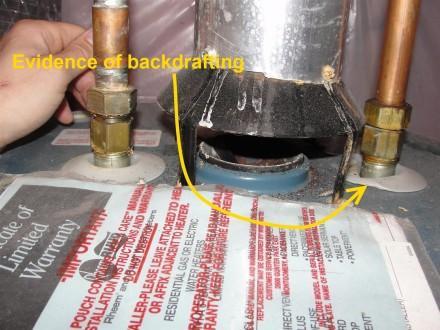
When the plastic at the top of a water heater is melted, it's pretty much a guarantee that the water heater has backdrafted. I've heard some folks claim that the plastic melted when the water heater was being installed, because someone got too close to the plastic with a torch while soldering the pipes. That's possible if the solder joints are very close to the water heater tank, but very highly unlikely, especially when the part that's most melted faces the draft hood.
Corrosion at the top of the tank
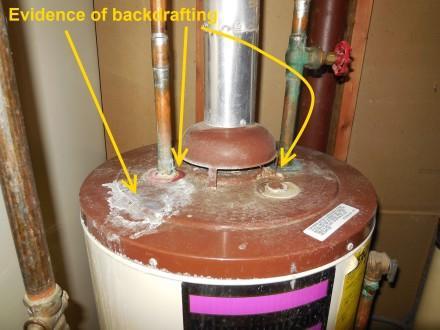
Backdrafting exhaust gases can condense at the top of the water heater tank. Over time, this corrosive condensate will begin to corrode the top of the tank. A leaking shutoff valve can also cause corrosion at the top of the tank, but that type of corrosion is easily distinguishable back corrosion caused by backdrafting because the worst area will be located directly below a valve.
Moisture at the top of the tank

If you can see condensation at the top of a water heater tank, you're basically watching the water heater backdraft. The photo below shows moisture, rust, and melted plastic at the top of the water heater. Click the photo to see a large version, showing this water heater backdrafting like crazy.
Excessive condensate on the cold water pipes in the water heater room
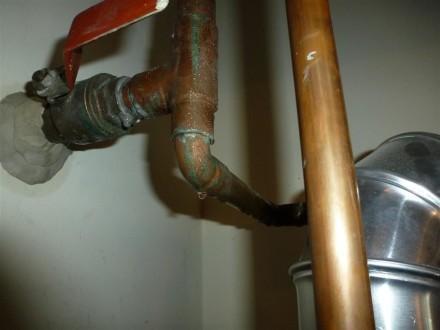
After a water heater has backdrafted for a while inside of a utility room, there will probably be heavy condensation on the cold water pipes. It's typical to see condensation on cold water pipes during the summer, but a backdrafting water heater will make it dramatically worse.
A marginal or improper installation of the vent connector

The vent connector at a water heater needs to pitch upwards towards the vent, and should ideally not have any quick turns, especially right at the draft hood.
If you find these types of clues, there might be a problem with the water heater drafting properly.
To test for proper water heater draft, I do the following:
- Turn down the heat at the furnace or boiler if there is a shared vent
- Close all windows and doors
- Close any fireplace dampers, if present
- Turn on any kitchen and bathroom exhaust fans
- Turn on the clothes dryer
- Run hot water at a bath tub or laundry sink long enough to get the water heater to kick on.
This creates a worst-case scenario for the water heater, but it should still draft properly under these conditions. Before testing the water heater draft, I give the water heater a few minutes to warm up; sometimes a water heater will initially backdraft for a minute or two, but will start drafting properly once the vent connector warms up enough.
I have several different tools that I can use to check for proper draft at a water heater if I'm feeling fancy, but there's really no need. To check for proper draft, I simply cup my hands around the draft hood without actually touching it.
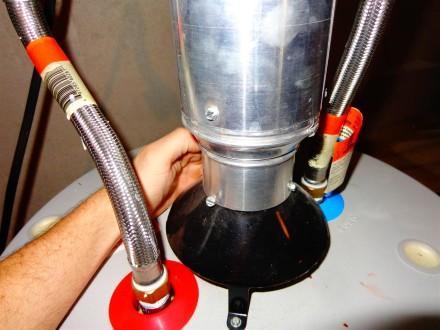
If the water heater is backdrafting, I'll feel warm, moist air coming out of the draft hood. If I want visual evidence to put in an inspection report, I can hold a mirror up the draft hood and take a picture of the mirror getting fogged up. The photo below shows a mirror that happened to be sitting on top of a backdrafting water heater during an inspection; I had to take a photo of that, right?
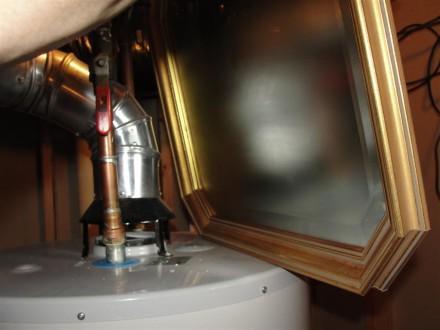
Another easy way to get visual evidence of a backdrafting water heater is to hold a camera close enough to the draft hood to allow the lens to get fogged up from the backdrafting flue gases. Powerful stuff, huh?

Next week I'll have a follow-up post on the causes of water heater backdrafting and what can be done about it.
Author: Reuben Saltzman, Structure Tech Home Inspections







